Tag: Carnegie Hall
BSO’s Bolcom @ Carnegie Hall
Back in the second tier boxes for the third and final of the Boston Symphony Orchestra’s concerts at Carnegie Hall this season. The BSO’s current music director James Levine is dear to New Yorkers for his relationship with the Metropolitan Opera, where he has led the orchestra since 1971.
The program at Stern Auditorium was to include two works by Franz Schubert and the New York debut of William Bolcom‘s Eighth Symphony for Chorus and Orchestra on William Blake’s Prophetic Books. That piece, which was commissioned by Levine for the BSO’s 125th Anniversary, had its world premiere the week before, in Boston.
German bass-baritone Thomas Quastoff had been scheduled to perform a series of five songs by Schubert, but like SC, he was derailed by illness and could not appear. (In SC’s stead, JG valiantly stepped in to accompany me to this evening’s concert.) Quasthoff is most visibly recognizable for his physical disability; he has a full-size torso, but shortened, malformed arms and stands at just under four feet tall as a result of his mother’s Thalidomide use during pregnancy. (His life story has inspired a movie.) Quasthoff has won three Grammys for his Deutsche Grammophon recordings, and last month won a fourth with EMI Classics for “Best Choral Performance” in Brahms: “Ein Deutsches Requiem”, conducted by Simon Rattle.
So instead, we were presented with Brahms’s violin-less Serenade No. 2 after Schubert’s “Tragic” Symphony No. 4.
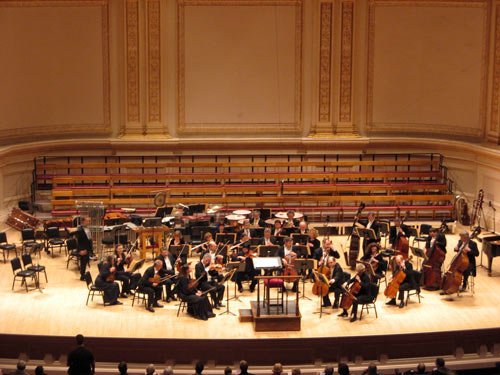
After intermission, the stage filled to near-overflowing for the Bolcom piece, which called for full strings and winds, extensive percussion and keyboards, and the Tanglewood Festival Chorus. (The Times and The Sun weigh in, positively.)
Bolcom’s best-known composition is another Blake inspiration, “Songs of Innocence and of Experience,” for which he won three 2006 Grammys, including “Best Classical Contemporary Composition.” The same year, the University of Michigan Professor of Composition was awarded the National Medal of Arts.
His Eighth Symphony began with a literal bang — jarring audience members in their seats — eventually settling into near musical rhythms. I was impressed that the chorus performed the whispering, wailing four-movement piece entirely from memory.
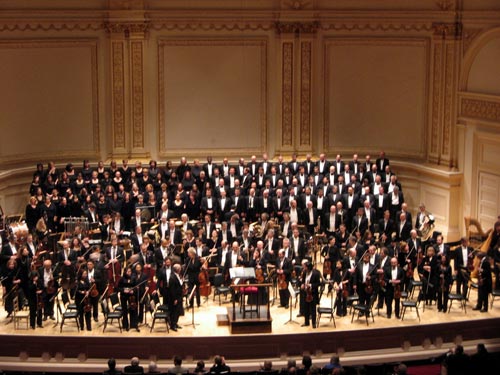
New England Symphonic Ensemble
At Carnegie Hall – not Lincoln Center, ahem! — for the New England Symphonic Ensemble program. It was an all choral line-up tonight, featuring Mozart’s Requiem, K. 626 as the highlight finale.
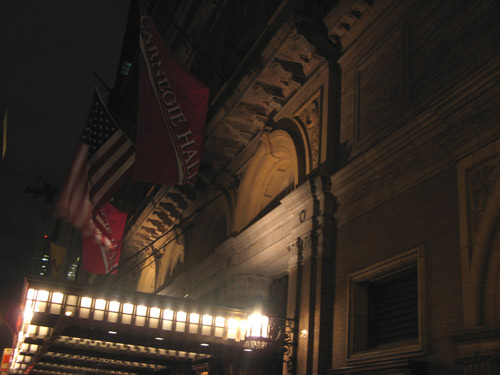
We had seats in the second tier center box, which was a perfect perch from which to take in the entire stage with its orchestra and hundreds of chorus members from five states. To start things off: George Frideric Handel’s “Sing Unto God” from his Judas Maccabeus, an oratorio written in 1746 — five years after Messiah. And then before the intermission break, Ralph Vaughan Williams’ Serenade to Music, which culls its lines from Act V of Shakespeare’s Merchant of Venice:
The man that hath no music in himself,/ Nor is not mov’d with concord of sweet sounds,/ Is fit for treasons, stratagems, and spoils;/ The motions of his spirit are dull as night,/ And his affections darks as Erebus:/ Let no such man be trusted.
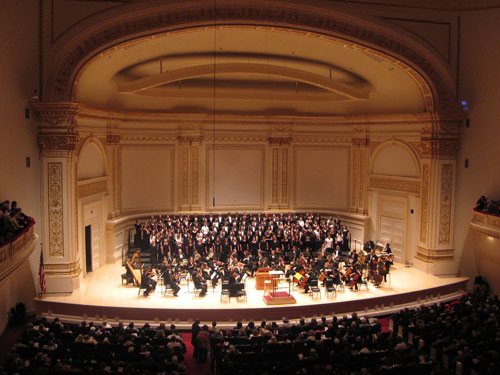
One distraction: although the program clearly requested that audience members hold their applause until after the final movement, we would invariably have to pause for the smatterings of claps at every break. Eh, whaddaya gonna do?
For the Requiem in D minor, a new set of choruses took the stage, many clad in navy choir robes. Mozart’s last composition is one of his most widely recognized works, not only for its music (which HYB posited as the only proof of the existence of God), but also for the mysterious circumstances surrounding the Requiem‘s commission, the debate over how much of the score is attributable to Mozart, and how much was later composed by his colleague Franz Xaver Süssmayr after Mozart’s death.
My first exposure to the score was in Amadeus. (Years later, though, my high school chorus learned excerpts of it for performance, including the rousing “Dies Irae“. And as I recall, the “Lacrimosa” was one of SS’s all-time favorite pieces of music.) That film went on to win eight Academy Awards, including best picture, and is responsible for cementing in many people’s minds several of the myths surrounding the Requiem (and of Mozart’s life, generally.) Foremost among these is the role of rival composer Antonio Salieri in commissioning the work, and ultimately hastening Mozart’s death.
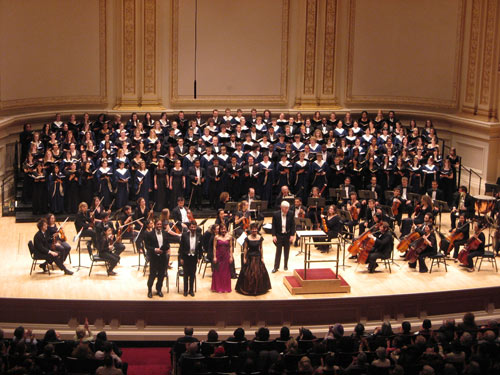
As I sat listening to the eminently moving music, it occurred to me that Amadeus, which recently played in New York as part of the Milos Forman retrospective at the MoMA, was released in 1984 — which is to say: before most of the members of these high school and college chorus members were even born.
Falco’s “Rock Me Amadeus” was released the following year, in 1985.
Famously good burgers
J had tickets to Carnegie Hall tonight, so we decided to meet for a quick dinner nearby before the concert. But where? We were about to fall back on our usual pre-Carnegie Hall standby — the Burger Joint inside Le Parker Meridien hotel — until we recalled that another burger joint had opened in the neighborhood recently.
The extraordinarily well-loved, family-owned Virginia-based chain of Five Guys Famous Burgers and Fries arrived in New York City last year — the East Coast’s answer to In-N-Out — opening branches in College Point and Brooklyn Heights. In early November, the first Manhattan outlet opened on 55th Street between Fifth and Sixth Avenues; the company plans to open 29(!) more in the borough over the next eight years. (That’s a lot, but nowhere near Starbucks’ level of ubiquity. But I digress…) By their second day of business, midtown lunch crowds had pushed waits for burgers and fries to an hour and half. Oh, what New Yorkers will endure for a good burger! Or good pizza!
At just past 7PM on a Monday, though, it is a decidedly less chaotic scene.
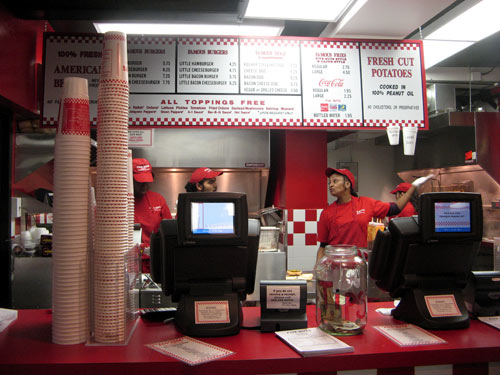
J had visited the Queens location before — they have a MySpace page! — but this was my first time sampling the famous burgers. Each one is made to order, and Five Guys provides all the shelled peanuts you can eat to tide you over while you’re waiting for your order number to be called.
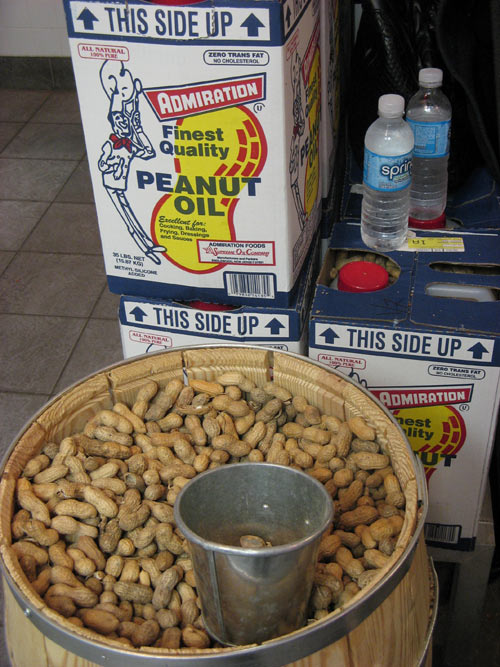
The corporate policy is to cook all beef patties to well done — eek! — in spite of which the burgers do retain a surprising level of juiciness. Usual toppings include lettuce, tomato, pickles, fried onions, sautéed mushrooms, ketchup, mustard and mayo; other less standard fixins include relish, jalapeño peppers, and green peppers, and all are included in the price. I ordered what’s listed on the menu as the “little hamburger,” which didn’t seem so “little” to me; roughly the same size as the ones at nearby Burger Joint, and at $2.00 less, a much better value. (The standard Five Guys burger comes with two 3.3 ounce patties, stacked one atop the other.) Five Guys fries are hand-cut, skin-on affairs. $4.50 for a large order (plain or cajun) seemed disproportionately expensive — a quarter more than my burger was, even — but are very generously proportioned; we essentially received double what we expected: inside our grease-stained brown paper bag was a tall styrofoam cup brimming full of fries, with roughly the same amount thrown in loose over our foil-wrapped burgers. Easily more fries than we could finish in a single sitting — and I love fries. Nice touch: bottles of malt vinegar on the tables. Goofy touch: announcing the provenance of the potatoes on a whiteboard by the registers. (“Today’s potatoes are from Ririe, Idaho.”)
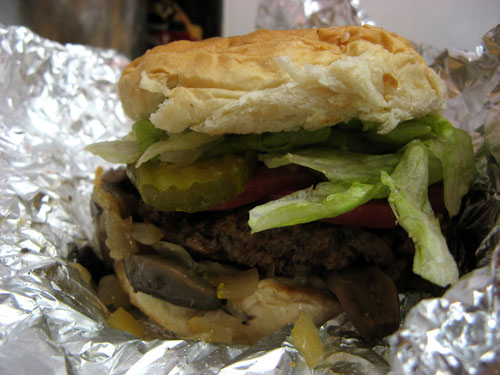
Peter Meehan of The New York Times had good things to say about those fries in his assessment of the Brooklyn branch (“Generously portioned… with an honest potato flavor”), but was less impressed with the burgers themselves, declaring them “not particularly salty or griddle-charred or beefy.” New York magazine was more effusive in its praise, recently naming Five Guys among the city’s best burgers; theirs was just one more article mounted along a long wall lined with glowing write-ups.
Non-press folks love them, too.
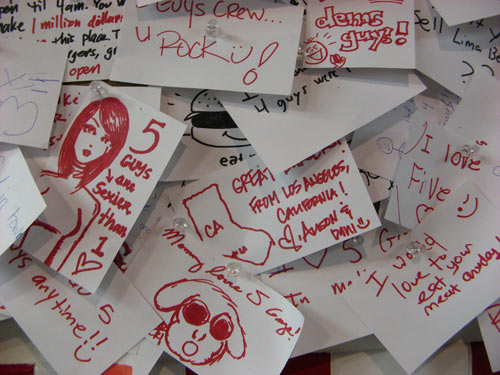
| S | M | T | W | T | F | S |
|---|---|---|---|---|---|---|
| 1 | 2 | |||||
| 3 | 4 | 5 | 6 | 7 | 8 | 9 |
| 10 | 11 | 12 | 13 | 14 | 15 | 16 |
| 17 | 18 | 19 | 20 | 21 | 22 | 23 |
| 24 | 25 | 26 | 27 | 28 | 29 | 30 |
Search
Popular Tags
Categories
Archive
- July 2010
- July 2009
- January 2009
- November 2008
- September 2008
- August 2008
- July 2008
- June 2008
- May 2008
- April 2008
- March 2008
- February 2008
- January 2008
- December 2007
- November 2007
- October 2007
- September 2007
- August 2007
- July 2007
- June 2007
- May 2007
- April 2007
- March 2007
- February 2007
- January 2007
- December 2006
- November 2006
- October 2006
- September 2006
- August 2006
- July 2006
- June 2006